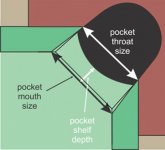I was hoping people would post data for some really "interesting" tables. For example, how about a 10' table with tight pockets? How about a triple-shimmed 9' table that spits out shots that would easily go on any reasonable table? How about a "bar box" that sucks quarters better than any other? Anybody have access to some of these? If so, please post the info along with your comments.Data reported by AZB users in table difficulty factor (TDF) order,
based on the table size factor (TSF), pocket size factor (PSF), pocket angle factor (PAF), and pocket shelf factor (PLF):
name -- TSF -- PSF -- PAF -- PLF -- TDF
example "B" -- 9':1.00 -- 3 7/8":1.20 -- 5/8":1.00 -- 1 7/8":1.03 -- 1.24
rexus31 -- 9':1.00 -- 4":1.20 -- 3/8":1.00 -- 1":1.00 -- 1.20
FatBoy -- 9':1.00 -- 4":1.20 -- 1/4":1.00 -- 1":1.00 -- 1.20
TATE -- 9':1.00 -- 4":1.20 -- 1/4":1.00 -- 7/8":1.00 -- 1.20
cigardave -- 9':1.00 -- 4 1/2":1.05 -- 3/4":1.02 -- 1 3/4":1.00 -- 1.07
SloMoHolic -- 9':1.00 -- 4 3/8":1.05 -- 5/8":1.00 -- 1 3/8":0.98 -- 1.03
Sloppy Pockets -- 8'+:0.95 -- 5":0.95 -- 1":1.10 -- 1 7/8":1.03 -- 1.02
"standard" table -- 9':1.00 -- 4 9/16":1.00 -- 9/16":1.00 -- 1 5/8":1.00 -- 1.00
Dopc -- 8':0.90 -- 4.5":1.05 -- 3/4":1.02 -- 1 1/4":1.00 -- 0.96
12squared -- 9':1.00 -- 4 7/8":0.95 -- 3/4":1.02 -- 1 1/2":0.98 -- 0.95
Neil -- 7':0.80 -- 4 1/8":1.10 -- 5/8":1.00 -- 1 3/8":1.00 -- 0.88
dr_dave -- 8':0.90 -- 4 3/4":0.95 -- 5/8":1.00 -- 1 3/8":0.98 -- 0.84
example "A" -- 8':0.90 -- 5":0.95 -- 1/2":0.98 -- 1 3/8":0.98 -- 0.82
Valley "bar box" -- 7':0.80 -- 4 1/2":1.05 -- 0":0.94 -- 3/4":0.95 -- 0.75
Thanks,
Dave
